人教版(2019)必修第三册Unit 2 Morals and Virtues Reading and Thinking课件(共22张PPT)
文档属性
| 名称 | 人教版(2019)必修第三册Unit 2 Morals and Virtues Reading and Thinking课件(共22张PPT) | 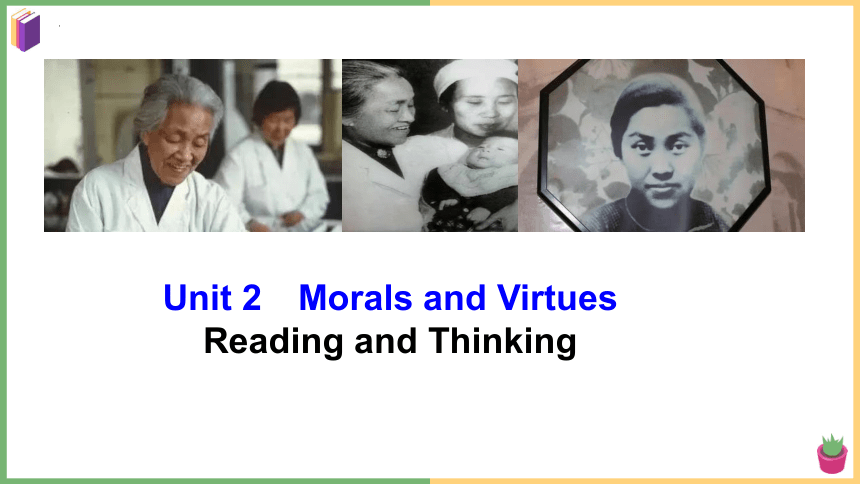 | |
| 格式 | pptx | ||
| 文件大小 | 8.8MB | ||
| 资源类型 | 教案 | ||
| 版本资源 | 人教版(2019) | ||
| 科目 | 英语 | ||
| 更新时间 | 2025-02-28 14:36:50 | ||
图片预览



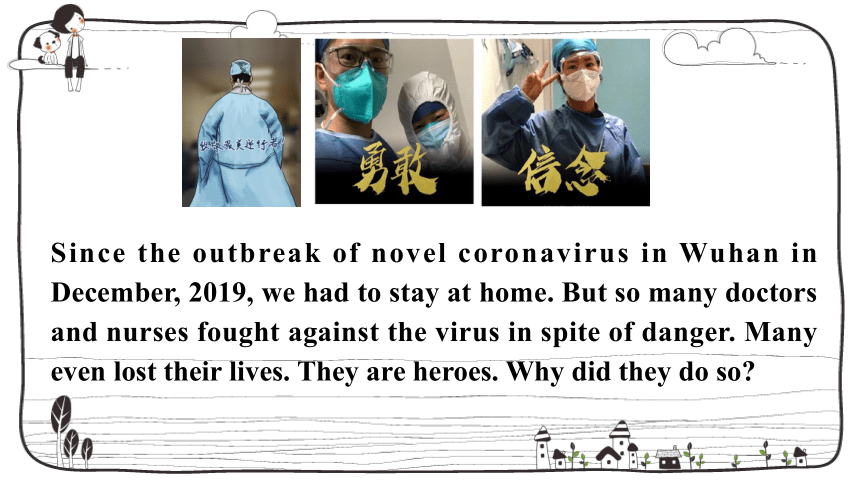

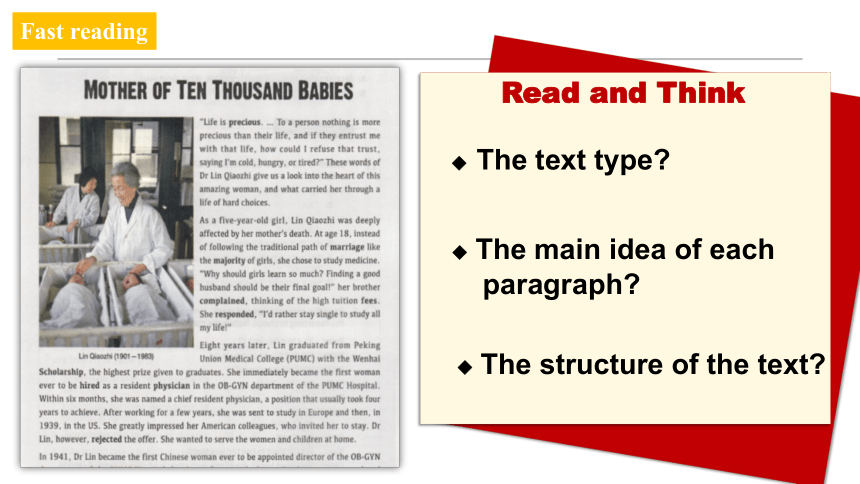
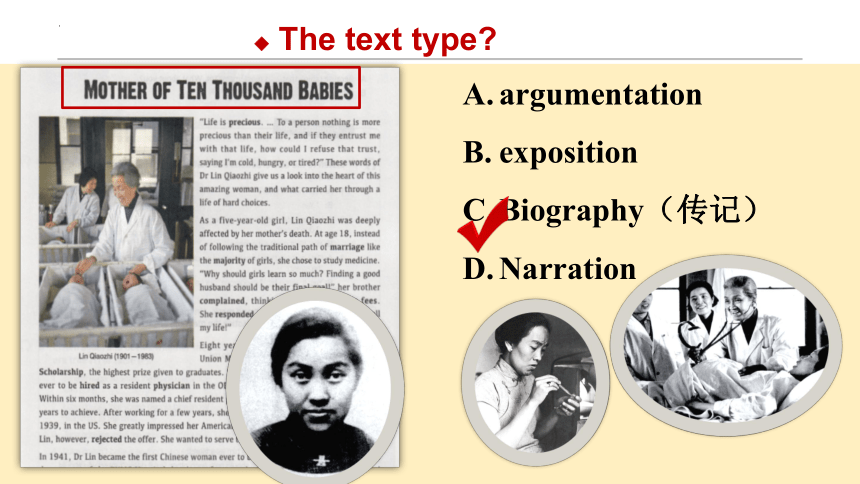

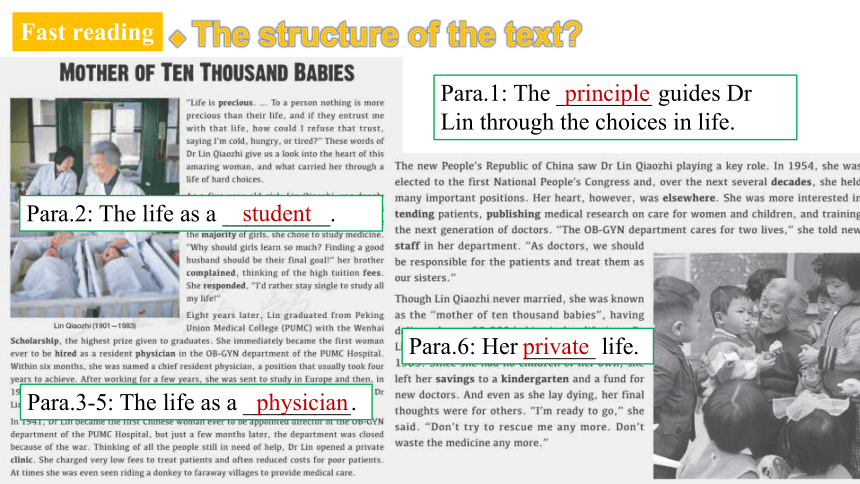
文档简介
(共22张PPT)
Unit 2 Morals and Virtues
Reading and Thinking
Think Share
1. What are some important life choices in your life
College entrance examination
a suitable job
……
university
study
jobs
marriage
partners
moral
decisions
…
They will determine:
how we live our lives and treat others;
how we are remembered by others;
the degree of respect and love we earn;
our own ability to have clean consciences and live with ourselves.
They determine our future.
What are some important life choices
life choices
Since the outbreak of novel coronavirus in Wuhan in December, 2019, we had to stay at home. But so many doctors and nurses fought against the virus in spite of danger. Many even lost their lives. They are heroes. Why did they do so
Preview & Predict
From the title and the pictures, we can know that the passage might be about _______________________________________.
a female doctor who delivered a lot of babies
◆ The text type
◆ The main idea of each
paragraph
◆ The structure of the text
Read and Think
Fast reading
◆ The text type
argumentation
exposition
Biography(传记)
Narration
Para.1 A. What Dr Lin did during the war.
Para.2 B. What Dr Lin did in the new China.
Para.3 C. Introduction(Dr Lin Qiaozhi's principle of life).
Para.4 D. Dr Lin’s ambition as a young girl.
Para.5 E. Dr Lin’ lifelong selfless devotion to medical work.
Para.6 F. Dr Lin’s studies and early career.
◆ The main idea of each paragraph
Para.1: The ________ guides Dr Lin through the choices in life.
Para.2: The life as a _________.
Para.3-5: The life as a _________.
physician
student
principle
◆ The structure of the text
Fast reading
Para.6: Her ______ life.
private
Scanning
In what order are the articles written
at five years old
at age 18
eight years later
in1939/1941...die
In time order
Scanning——make a timeline
different periods of Dr Lin
Dr Lin’s life choices in different periods
Thread
Transition
1901
age 5
age 18
8 years later
within 6 months
after working for a few years
1939
1941
a few months later
1954
over the next several decades
22 April 1983
Scanning——make a timeline
1901
age 5
age 18
8 years later
within 6 months
after working for a few years
1939
1941
a few months later
1954
over the next several decades
22 April 1983
She was named a chief resident physician.
She was born.
Her mother died.
She chose to study medicine.
She studied in Europe.
The department was closed.
She studied in the US.
She was elected to the first National People's Congress.
She became the first Chinese woman director at PUMC.
She died.
She graduated from PUMC.
She held many important positions.
“Life is precious....To a person nothing is more precious than their life, and if they entrust me with that life, how could I refuse that trust, saying I'm cold, hungry, or tired "These words of Dr Lin Qiaozhi give us a look into the heart of this amazing woman, and what carried her through a life of hard choices.
As a five-year-old girl, Lin Qiaozhi was deeply affected by her mother's death. At age 18, instead of following the traditional path of marriage like the majority of girls, she chose to study medicine. "Why should girls learn so much Finding a good husband should be their final goal! " her brother complained, thinking of the high tuition fees. She responded, "I'd rather stay single to study all my life!"
Eight years later, Lin graduated from Peking Union Medical College (PUMC) with the Wenhai Scholarship, the highest prize given to graduates. She immediately became the first woman ever to be hired as a resident physician in the OB-GYN department(妇产科) of the PUMC Hospital. Within six months, she was named a chief resident physician, a position that usually took four years to achieve. After working for a few years, she was sent to study in Europe and then, in 1939, in the US. She greatly impressed her American colleagues, who invited her to stay. Dr Lin, however, rejected the offer. She wanted to serve the women and children at home.
In 1941, Dr Lin became the first Chinese woman ever to be appointed director of the OB-GYN department of the PUMC Hospital, but just a few months later, the department was closed because of the war. Thinking of all the people still in need of help, Dr Lin opened a private clinic. She charged very low fees to treat patients and often reduced costs for poor patients. At times she was even seen riding a donkey to faraway villages to provide medical care.
The new People's Republic of China saw Dr Lin Qiaozhi playing a key role. In 1954, she was elected to the first National People's Congress and, over the next several decades, she held many important positions. Her heart, however, was elsewhere. She was more interested in tending patients, publishing medical research on care for women and children, and training the next generation of doctors. “The OB-GYN department cares for two lives,” she told new staff in her department. “As doctors, we should be responsible for the patients and treat them as our sisters.”
Though Lin Qiaozhi never married, she was known as the "mother of ten thousand babies", having delivered over 50,000 babies in her lifetime. Dr Lin did not retire until the day she died, 22 April 1983. Since she had no children of her own, she left her savings to a kindergarten and a fund for new doctors. And even as she lay dying, her final thoughts were for others. "I'm ready to go,“ she said.“ Don't try to rescue me any more. Don’t waste the medicine any more."
The choice she made when she was young.
1) What hard choices was Dr Lin faced with throughout her life Underline the sentences about these choices.
The choice she made when she worked as a physician.
The choice she made during the war.
The choice she made when she held many important positions.
The choice she made before she passed away.
“Life is precious....To a person nothing is more precious than their life, and if they entrust me with that life, how could I refuse that trust, saying I'm cold, hungry, or tired "These words of Dr Lin Qiaozhi give us a look into the heart of this amazing woman, and what carried her through a life of hard choices.
As a five-year-old girl, Lin Qiaozhi was deeply affected by her mother's death. At age 18, instead of following the traditional path of marriage like the majority of girls, she chose to study medicine. "Why should girls learn so much Finding a good husband should be their final goal! " her brother complained, thinking of the high tuition fees. She responded, "I'd rather stay single to study all my life!"
Eight years later, Lin graduated from Peking Union Medical College (PUMC) with the Wenhai Scholarship, the highest prize given to graduates. She immediately became the first woman ever to be hired as a resident physician in the OB-GYN department(妇产科) of the PUMC Hospital. Within six months, she was named a chief resident physician, a position that usually took four years to achieve. After working for a few years, she was sent to study in Europe and then, in 1939, in the US. She greatly impressed her American colleagues, who invited her to stay. Dr Lin, however, rejected the offer. She wanted to serve the women and children at home.
In 1941, Dr Lin became the first Chinese woman ever to be appointed director of the OB-GYN department of the PUMC Hospital, but just a few months later, the department was closed because of the war. Thinking of all the people still in need of help, Dr Lin opened a private clinic. She charged very low fees to treat patients and often reduced costs for poor patients. At times she was even seen riding a donkey to faraway villages to provide medical care.
The new People's Republic of China saw Dr Lin Qiaozhi playing a key role. In 1954, she was elected to the first National People's Congress and, over the next several decades, she held many important positions. Her heart, however, was elsewhere. She was more interested in tending patients, publishing medical research on care for women and children, and training the next generation of doctors. “The OB-GYN department cares for two lives,” she told new staff in her department. “As doctors, we should be responsible for the patients and treat them as our sisters.”
Though Lin Qiaozhi never married, she was known as the "mother of ten thousand babies", having delivered over 50,000 babies in her lifetime. Dr Lin did not retire until the day she died, 22 April 1983. Since she had no children of her own, she left her savings to a kindergarten and a fund for new doctors. And even as she lay dying, her final thoughts were for others. "I'm ready to go,“ she said.“ Don't try to rescue me any more. Don’t waste the medicine any more."
She didn’t get married.
She didn’t stay in the US.
She opened a private clinic.
She tended patients, published medical research and trained doctors instead of government work.
She donated all her money.
2) What were the results of her choices
1. What was the main principle guiding Dr Lin through the choices in her life
2. What kind of person do you think Dr Lin was
Find out the supporting details.
While reading
The principle was to deny herself and put others first.
guiding principle
put others first
Para.1: “Life is precious. ... To a person nothing is more precious than their life, and if they entrust me with that life, how could I refuse that trust, saying I'm cold, hungry, or tired ”
Para.6: And even as she lay dying, her final thoughts were for others.
life first
ignore herself
deny herself
As a student: determined,outstanding
As a Chinese: patriotic,selfless
As a doctor: professional,kind, devoted
generous
helpful
kind-hearted
caring
responsible
hard-working
dedicated
(敬业的)
determined
selfless(无私的)
talented
devoted
(奉献的)
patriotic
(爱国的)
respectable
diligent
(勤奋的)
strong-minded
professional
considerate(体贴的)
intelligent
(聪慧的)
outstanding(卓越的)
passionate(热情的)
compassionate
(有同情心的)
Discussion
If you were Dr Lin, would you give up your marriage and devote your entire life to the patients
Summary
We all make choices, but in the end, our choices make us.
Thanks
Unit 2 Morals and Virtues
Reading and Thinking
Think Share
1. What are some important life choices in your life
College entrance examination
a suitable job
……
university
study
jobs
marriage
partners
moral
decisions
…
They will determine:
how we live our lives and treat others;
how we are remembered by others;
the degree of respect and love we earn;
our own ability to have clean consciences and live with ourselves.
They determine our future.
What are some important life choices
life choices
Since the outbreak of novel coronavirus in Wuhan in December, 2019, we had to stay at home. But so many doctors and nurses fought against the virus in spite of danger. Many even lost their lives. They are heroes. Why did they do so
Preview & Predict
From the title and the pictures, we can know that the passage might be about _______________________________________.
a female doctor who delivered a lot of babies
◆ The text type
◆ The main idea of each
paragraph
◆ The structure of the text
Read and Think
Fast reading
◆ The text type
argumentation
exposition
Biography(传记)
Narration
Para.1 A. What Dr Lin did during the war.
Para.2 B. What Dr Lin did in the new China.
Para.3 C. Introduction(Dr Lin Qiaozhi's principle of life).
Para.4 D. Dr Lin’s ambition as a young girl.
Para.5 E. Dr Lin’ lifelong selfless devotion to medical work.
Para.6 F. Dr Lin’s studies and early career.
◆ The main idea of each paragraph
Para.1: The ________ guides Dr Lin through the choices in life.
Para.2: The life as a _________.
Para.3-5: The life as a _________.
physician
student
principle
◆ The structure of the text
Fast reading
Para.6: Her ______ life.
private
Scanning
In what order are the articles written
at five years old
at age 18
eight years later
in1939/1941...die
In time order
Scanning——make a timeline
different periods of Dr Lin
Dr Lin’s life choices in different periods
Thread
Transition
1901
age 5
age 18
8 years later
within 6 months
after working for a few years
1939
1941
a few months later
1954
over the next several decades
22 April 1983
Scanning——make a timeline
1901
age 5
age 18
8 years later
within 6 months
after working for a few years
1939
1941
a few months later
1954
over the next several decades
22 April 1983
She was named a chief resident physician.
She was born.
Her mother died.
She chose to study medicine.
She studied in Europe.
The department was closed.
She studied in the US.
She was elected to the first National People's Congress.
She became the first Chinese woman director at PUMC.
She died.
She graduated from PUMC.
She held many important positions.
“Life is precious....To a person nothing is more precious than their life, and if they entrust me with that life, how could I refuse that trust, saying I'm cold, hungry, or tired "These words of Dr Lin Qiaozhi give us a look into the heart of this amazing woman, and what carried her through a life of hard choices.
As a five-year-old girl, Lin Qiaozhi was deeply affected by her mother's death. At age 18, instead of following the traditional path of marriage like the majority of girls, she chose to study medicine. "Why should girls learn so much Finding a good husband should be their final goal! " her brother complained, thinking of the high tuition fees. She responded, "I'd rather stay single to study all my life!"
Eight years later, Lin graduated from Peking Union Medical College (PUMC) with the Wenhai Scholarship, the highest prize given to graduates. She immediately became the first woman ever to be hired as a resident physician in the OB-GYN department(妇产科) of the PUMC Hospital. Within six months, she was named a chief resident physician, a position that usually took four years to achieve. After working for a few years, she was sent to study in Europe and then, in 1939, in the US. She greatly impressed her American colleagues, who invited her to stay. Dr Lin, however, rejected the offer. She wanted to serve the women and children at home.
In 1941, Dr Lin became the first Chinese woman ever to be appointed director of the OB-GYN department of the PUMC Hospital, but just a few months later, the department was closed because of the war. Thinking of all the people still in need of help, Dr Lin opened a private clinic. She charged very low fees to treat patients and often reduced costs for poor patients. At times she was even seen riding a donkey to faraway villages to provide medical care.
The new People's Republic of China saw Dr Lin Qiaozhi playing a key role. In 1954, she was elected to the first National People's Congress and, over the next several decades, she held many important positions. Her heart, however, was elsewhere. She was more interested in tending patients, publishing medical research on care for women and children, and training the next generation of doctors. “The OB-GYN department cares for two lives,” she told new staff in her department. “As doctors, we should be responsible for the patients and treat them as our sisters.”
Though Lin Qiaozhi never married, she was known as the "mother of ten thousand babies", having delivered over 50,000 babies in her lifetime. Dr Lin did not retire until the day she died, 22 April 1983. Since she had no children of her own, she left her savings to a kindergarten and a fund for new doctors. And even as she lay dying, her final thoughts were for others. "I'm ready to go,“ she said.“ Don't try to rescue me any more. Don’t waste the medicine any more."
The choice she made when she was young.
1) What hard choices was Dr Lin faced with throughout her life Underline the sentences about these choices.
The choice she made when she worked as a physician.
The choice she made during the war.
The choice she made when she held many important positions.
The choice she made before she passed away.
“Life is precious....To a person nothing is more precious than their life, and if they entrust me with that life, how could I refuse that trust, saying I'm cold, hungry, or tired "These words of Dr Lin Qiaozhi give us a look into the heart of this amazing woman, and what carried her through a life of hard choices.
As a five-year-old girl, Lin Qiaozhi was deeply affected by her mother's death. At age 18, instead of following the traditional path of marriage like the majority of girls, she chose to study medicine. "Why should girls learn so much Finding a good husband should be their final goal! " her brother complained, thinking of the high tuition fees. She responded, "I'd rather stay single to study all my life!"
Eight years later, Lin graduated from Peking Union Medical College (PUMC) with the Wenhai Scholarship, the highest prize given to graduates. She immediately became the first woman ever to be hired as a resident physician in the OB-GYN department(妇产科) of the PUMC Hospital. Within six months, she was named a chief resident physician, a position that usually took four years to achieve. After working for a few years, she was sent to study in Europe and then, in 1939, in the US. She greatly impressed her American colleagues, who invited her to stay. Dr Lin, however, rejected the offer. She wanted to serve the women and children at home.
In 1941, Dr Lin became the first Chinese woman ever to be appointed director of the OB-GYN department of the PUMC Hospital, but just a few months later, the department was closed because of the war. Thinking of all the people still in need of help, Dr Lin opened a private clinic. She charged very low fees to treat patients and often reduced costs for poor patients. At times she was even seen riding a donkey to faraway villages to provide medical care.
The new People's Republic of China saw Dr Lin Qiaozhi playing a key role. In 1954, she was elected to the first National People's Congress and, over the next several decades, she held many important positions. Her heart, however, was elsewhere. She was more interested in tending patients, publishing medical research on care for women and children, and training the next generation of doctors. “The OB-GYN department cares for two lives,” she told new staff in her department. “As doctors, we should be responsible for the patients and treat them as our sisters.”
Though Lin Qiaozhi never married, she was known as the "mother of ten thousand babies", having delivered over 50,000 babies in her lifetime. Dr Lin did not retire until the day she died, 22 April 1983. Since she had no children of her own, she left her savings to a kindergarten and a fund for new doctors. And even as she lay dying, her final thoughts were for others. "I'm ready to go,“ she said.“ Don't try to rescue me any more. Don’t waste the medicine any more."
She didn’t get married.
She didn’t stay in the US.
She opened a private clinic.
She tended patients, published medical research and trained doctors instead of government work.
She donated all her money.
2) What were the results of her choices
1. What was the main principle guiding Dr Lin through the choices in her life
2. What kind of person do you think Dr Lin was
Find out the supporting details.
While reading
The principle was to deny herself and put others first.
guiding principle
put others first
Para.1: “Life is precious. ... To a person nothing is more precious than their life, and if they entrust me with that life, how could I refuse that trust, saying I'm cold, hungry, or tired ”
Para.6: And even as she lay dying, her final thoughts were for others.
life first
ignore herself
deny herself
As a student: determined,outstanding
As a Chinese: patriotic,selfless
As a doctor: professional,kind, devoted
generous
helpful
kind-hearted
caring
responsible
hard-working
dedicated
(敬业的)
determined
selfless(无私的)
talented
devoted
(奉献的)
patriotic
(爱国的)
respectable
diligent
(勤奋的)
strong-minded
professional
considerate(体贴的)
intelligent
(聪慧的)
outstanding(卓越的)
passionate(热情的)
compassionate
(有同情心的)
Discussion
If you were Dr Lin, would you give up your marriage and devote your entire life to the patients
Summary
We all make choices, but in the end, our choices make us.
Thanks
